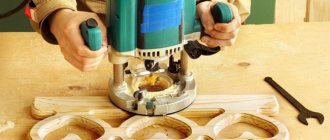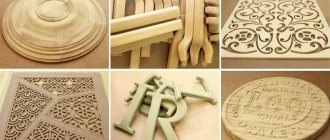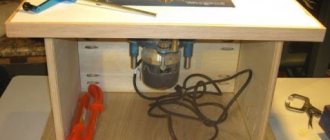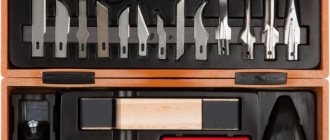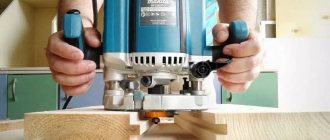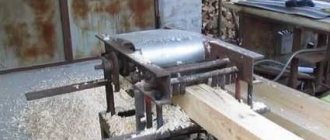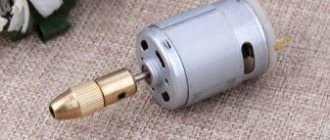For wood processing, various machines and devices are used, with the help of which wooden blanks are given the required shape and configuration. For large volumes, industrial equipment (machines, sawmills, etc.) is used for these purposes, and for small volumes, for a home or workshop, the work is performed using hand tools. One type of such equipment used for processing wooden surfaces is a manual wood router, which will be discussed in this article in the online magazine HomeMyHome.ru.
Hand-held wood routers are an indispensable assistant for the home craftsman in making furniture and performing figured carvings.
Scope of application
Hand-held wood routers are a tool in which the cutting element is a milling cutter installed in a collet-type chuck, which, in turn, is placed in a mechanical gearbox driven by an electric motor.
Manual milling cutters are used for:
- drilling holes of any diameter and shape, which depends on the size of the cutters used;
- leveling wooden surfaces, as well as the contours of parts and wooden blanks;
- cutting various grooves, splines and tenons;
- profiling of various types of edges;
- making decorative carvings.
Carving is one of the main functions of hand-held wood routers, and for drilling and leveling, as a rule, special types of hand tools (drills, planes, etc.) are used.
Artistic carving is one of the uses of such a tool
The best vertical models
Plunge hand milling cutters will allow you to effortlessly create grooves, holes, curves, and chamfer at home and in production conditions.
Rating of the TOP 4 best vertical wood routers in terms of price and quality ratio.
ELITECH F 1800E, 1800 W
The inexpensive vertical router ELITECH F 1800E with a power of 1.8 kW is a specialized tool for preparing various decorative elements and carrying out high-quality processing of materials.
The device provides processing of workpieces to a depth of up to 5.5 cm.
The device is equipped with a starting current limiter with a smooth increase in speed, eliminating overload and equipment breakdown.
The router is powered from a 220 volt network.
The unit is equipped with a lighting system for the treated area, a speed controller with an adjustment range from 12,000 to 25,000 rpm, and an option for connecting a vacuum cleaner.
The device is equipped with a parallel guide, a key and collets.
Specifications:
- power consumption - 1.8 kW;
- rotation speed - 12000-25000 rpm;
- milling depth - 5.5 cm;
- collet sizes - 8 mm, 12 mm;
- network cable length - 2.5 m;
- product weight - 4.3 kg;
- features - speed controller, soft start, turret stop, fine tuning, spindle lock, connection for a vacuum cleaner, backlight.
Advantages
- smooth start;
- wide micro-adjustment range;
- bright backlight;
- Ease of use.
Flaws
- slight play;
- lack of a case;
- inconvenient connection of the vacuum cleaner.
BOSCH POF 1400 ACE 060326C820, 1400 W
The affordable vertical router BOSCH POF 1400 ACE 060326C820 with a power of 1.4 kW is designed for working with wood, including for figured carving, creating complex holes, and cutting grooves for hinges.
The device provides a milling depth of up to 5.5 cm.
The device is equipped with a manual micro-adjustment option with an accuracy of 0.1 mm, an electronic stabilization system, and a copy sleeve with the ability to install without the use of additional tools.
Electronic control allows you to adjust the rotation speed from 11,000 to 28,000 rpm.
The device is equipped with backlighting, soft start, and a cover to protect the device from dust. The noise level of the device does not exceed 95 dB.
The kit includes an adapter, a key, a bushing, a case, an 8 mm cutter, a rip fence, a centering rod, and collet chucks.
Specifications:
- power consumption - 1.4 kW;
- rotation speed - 11000-28000 rpm;
- milling depth - 5.5 cm;
- collet sizes - 6 mm, 8 mm, 1/4″;
- product weight - 3.5 kg;
- features - cast sole, speed regulator, speed stabilization, soft start, turret stop, fine tuning, spindle lock, vacuum cleaner connection, backlight.
Advantages
- good functionality;
- ergonomic handles;
- accuracy of work;
- no vibration.
Flaws
- tight elevator mechanism;
- poor quality rip fence;
- The depth and adjustment scales are erased.
BOSCH POF 1400 ACE + 6 cutters, 1400 W
The professional vertical router BOSCH POF 1400 ACE with 6 cutters included and a 1.4 kW motor will ensure efficient work with wooden surfaces, as well as with products made from various mineral materials.
The unit supports the ability to change the speed from 11,000 to 28,000 units per minute.
The device is equipped with constant electronics, a copy sleeve, and ergonomic handles with rubber pads.
The noise level of a working model does not exceed 95 dB.
The product is equipped with a suction adapter, an open-end wrench, a case, a rip fence, a centering rod, three collet chucks, and a set of cutters.
Specifications:
- power consumption - 1.4 kW;
- rotation speed - 11000-28000 rpm;
- milling depth - 5.5 cm;
- collet sizes - 6 mm, 8 mm, 1/4″;
- product weight - 3.5 kg;
- features - speed control, speed stabilization, turret stop, fine tuning, spindle lock, connection for a vacuum cleaner, backlight.
Advantages
- affordable price;
- high build quality;
- ergonomic design;
- bright backlight.
Flaws
- the elevator is slow;
- heavy weight.
BOSCH POF 1200 AE 060326A100, 1200 W
Professional-grade vertical router BOSCH POF 1200 AE 060326A100 with a power of 1.2 kW is a specialized tool designed for cutting grooves necessary for connecting wooden structures and shaped elements.
The device provides high productivity when performing complex work with dense wood.
The device is equipped with electronic control of motor speed, spindle lock, and a copy sleeve that can be installed without special tools.
The device is equipped with a dust removal system, a transparent casing, and an ergonomic handle with a pad.
The noise level of the operating unit is 95 dB.
The router is equipped with an adapter, a wrench, 8 mm accessories, a rip fence, collets and a centering rod.
Specifications:
- power consumption - 1.2 kW;
- rotation speed - 11000-28000 rpm;
- milling depth - 5.5 cm;
- collet sizes - 6 mm, 8 mm, 1/4″;
- product weight - 3.4 kg;
- features - cast sole, speed regulator, turret stop, fine adjustment, spindle lock, keyless replacement of equipment, connection of a vacuum cleaner.
Advantages
- high-quality execution;
- rich equipment;
- high quality milling;
- comfortable grip.
Flaws
- lack of microlift;
- rough elevator movement;
- only one cutter included.
Types of manual milling machines
Manual milling machines are classified according to:
- Type of use – domestic and professional use.
- Purpose – universal and narrow-profile use.
- Constructions.
The type of use of a tool is determined by its technical characteristics and functionality. Professional models can be narrow-profile, when they can be used to perform certain types of operations, and universal ones are devices for household and professional use, with which you can perform various types of wood processing operations.
The edge router is a narrow-profile tool
According to the design and types of operations performed, manual milling machines are classified as follows:
- submersible (vertical or rod) - universal-purpose devices, the most common type of tool of this type;
- edge (edging) - narrow-profile models, used for cutting grooves, grooves, chamfering in woodworking industries;
- lamella – designed for cutting grooves;
- filler (dowel) – used in furniture production for drilling paired holes for dowels.
Additive milling cutters are convenient for the manufacture of cabinet furniture.
Manual wood milling cutters which is better is decided by each user individually, in accordance with the purpose of the tool and the nature of its use.
Types of milling cutters
Manual machines are divided into four types:
- upper;
- edge;
- lamella;
- combined.
Most hand-held milling cutters - universal or overhead - are equipped with a lift for lowering and raising the cutter relative to the surface being processed. Used to solve dozens of problems. Plunge models can be lowered and raised with a rotating cutter.
Classic model
An edge router is a low-power, compact device for chamfering and profiling edges - giving them round or complex shapes. It is used to form decorative grooves on baseboards, platbands, and cornices. It is equipped with a small-sized sole, allowing you to maneuver and fit in confined spaces and on narrow surfaces.
Thanks to its light weight and size, it is comfortable to hold with one hand. Often the base of the machine is rotated to expand the list of tasks it performs.
For edge processing
Edge-loop milling cutters are adapted for making passes under hinges.
A lamellar or filler milling cutter is a highly specialized tool. Looks like an angle grinder or grinder with a sole. A saw blade is used as a cutting tool. Its task is exclusively to create grooves or cuts in the shape of a crescent for installing lamellas when connecting parts for gluing panels. A lamellar router can be used to select quarters. A thin disk cutter - saw is used as a cutting tool.
Additive
Combined router - equipped with several soles or bases; the most common models are with three bases:
- inclined – for milling at an angle;
- submersible – allows you to quickly change the immersion depth of the cutter, including without stopping it;
- edging – miniature, designed for processing the edges of products.
Combined
Main technical characteristics
Any type of tool and equipment, technical devices and devices are characterized by certain technical characteristics that determine their capabilities.
For manual wood routers, these characteristics are:
- electrical power, measured in watts;
- spindle speed, measured in revolutions per minute.
In addition, the following indicators are important technical parameters:
- availability of protection and automation systems;
- material used in the manufacture of the “sole” of the instrument;
- immersion depth (working stroke) of the cutter, measured in mm;
- dimensions of the equipment fastening unit (diameter), measured in mm or inches;
- the presence of auxiliary elements - stops and guides.
When cutting grooves, a hand router is simply irreplaceable.
Electrical power determines the type of use of the tool: professional models are equipped with more powerful electric motors and, conversely, household models are equipped with less powerful ones. It should also be taken into account that the more powerful the engine, the heavier the tool.
According to this indicator, milling cutters are classified as:
- light – power up to 0.7 kW;
- medium - the power of such devices is 0.7–1.5 kW;
- heavy - more than 1.5 kW.
For universal-purpose models, the spindle speed is 20,000–30,000 rpm, and for edge-type models, this figure is 35,000 rpm.
Important! When working with manual milling machines, it should be remembered that the higher the spindle rotation speed, the cleaner the processed surface is and the easier it is to process hard wood.
Using a hand router, you can make wooden blanks of any shape and configuration. The following
can be installed as automation and protection systems on various models of hand routers:
- spindle speed stabilization systems under load;
- smooth start of the electric motor;
- overload protection;
- protection against unintentional start-up.
The type of sole and the working stroke of the cutter, as well as the attachment point and auxiliary elements, relate to the design features of a particular model.
What does a milling cutter consist of?
An electric tool consists of a number of fundamental components, without which its operation is impossible. Advanced models have additional components and equipment.
- Electric motor – provides torque to the cutting tool.
- Gearbox – transmits rotational force from the motor shaft to the cutter.
- Spindle block with collet chuck - holds the shank of the cutting tool.
- Switch with speed control.
- Unit for adjusting and limiting the immersion depth of the cutter.
- Parallel fence - milling along the edge of the board.
- A pair of spring-loaded rods for raising and lowering the mechanism above the platform and the surface being processed.
- Guide plate – the machine structure rests on it.
Main elements and components
The milling cutters are also equipped with a rotary buffer - it will help in cutting out circles, copy plates for working according to a template, a system for connecting a dust exhaust, and precise adjustment of the depth of immersion of the cutter.
Design features of the main components
The sole of the device is an important structural element that determines the purpose of the tool and the nature of its use. Household and budget models have soles made of stamped metal; more expensive, professional models are equipped with platforms made of aluminum alloys.
The presence of stops and guides simplifies the use of the tool
All additional devices and guide mechanisms are attached to the sole, as well as vertical rods. The working surface of the platform, its lower part, must have a special overlay made of plastic or dense wood. The working stroke of the cutter is determined by the design of the rod mechanism, and it is this indicator that determines the functionality and performance of a tool of this type.
The head part of the device moves along guide rods, and the amount of immersion is adjusted using handles. It can be fixed using a special lever located on one of the handles or with a special screw. Some models are manufactured with a removable head, which allows them to be used as a permanently mounted straight grinder or drill.
Universal milling machine "Bosch" model "GMF 1600 CE L-Boxx" with a removable head
The range of cutters available for use with a specific router model depends on the attachment point of the equipment, because The diameter of the cutter must correspond to the diameter of the collet chuck. If the diameter of the mounting hole of the fastening unit is larger than the diameter of the cutter shank, then you can use special adapter bushings, which can be purchased separately from the cutters if they are not included in the delivery set. The presence of stops and guides allows you to process workpieces with a high degree of accuracy and facilitates the performance of complex and time-consuming operations.
The best stripping models
Stripping milling cutters will ensure high-quality, quick removal of plaster and the removal of any other old coatings as part of the repair or restoration of any object.
Review of the best deburring routers for the home workshop based on customer reviews and ratings.
Metabo LF 724 S, 710 W
The advanced stripping milling cutter Metabo LF 724 S with a power of 0.71 kW is an ideal solution for carrying out restoration work, removing paint and varnish from wooden surfaces, and high-quality processing of folds.
The device is powered from a 220 volt network. The length of the cable for connecting to the outlet is 4 meters.
The device is equipped with a spindle lock option, carbide metal knives, and a pipe for connecting a vacuum cleaner.
The gearbox housing in this model is made of particularly durable aluminum alloy.
The noise level of operating equipment does not exceed 86 dB. The device is equipped with equipment, a case, an awl, and a combination wrench.
Specifications:
- power consumption - 0.71 kW;
- rotation speed - 10000 rpm;
- network cable length - 4 m;
- product weight - 2.4 kg;
- Features: cast sole, spindle lock, connection for a vacuum cleaner.
Advantages
- high quality milling;
- reliable and productive equipment;
- smooth adjustment of the removed layer;
- long network cable.
Flaws
- high price;
- decent noise level;
- Not a sealed dust container.
Additional equipment for manual milling machines
As a rule, hand-held milling cutters come with various guides and other auxiliary devices, but if they are not enough, you can always purchase them separately or make them yourself.
The presence of additional equipment expands the functionality of the tool
Additional accessories for hand routers include stops and a guide rail, a copy sleeve and an angular stop, as well as a compass ruler. Parallel and horizontal stops allow you to process workpieces at an equal distance from the edge (edge) of these elements, and the guide rail serves for linear movement of the router. The copying sleeve is a round plate, equipped with a side, inserted into the opening of the support platform and providing support around the working cutter. An angular stop is used when making a copy of a finished product, and a compass ruler helps to process workpieces along a certain radius.
The copy bushing for the router is a stamped product
The most popular types of cutters for a manual wood router
The industry produces various types of cutters used with manual wood routers; they are classified as follows:
- shank diameter – 6.8 and 12 mm;
- by design - prefabricated, with replaceable cutting edges and monolithic;
- by blade type - high-speed cutting (HM) and carbide (HSS);
- by purpose - groove and edge, combined and for the manufacture of linings, frame and figured.
When choosing a wood cutter for a hand router, in order not to make a mistake when purchasing, you need to familiarize yourself with the catalog of similar products, which can always be found on the Internet or from companies that sell woodworking equipment. Many manufacturers offer for sale sets of wood cutters for hand routers, varying in configuration and purpose.
A set of end mills for a hand router of the SMT brand
Among users, the most popular sets of wood cutters for hand routers are from domestic and foreign manufacturers: instrumental (Russia), “CMT Utensili SpA” (Italy) and “Dimar Group Ltd” (Israel) .
Related article:
Woodworking machines for the home workshop. Specialized equipment with an electric drive greatly simplifies the processing of wood blanks. But acquiring it involves significant investments. To successfully solve this problem, you should carefully study the materials in this article.
Review of popular models of manual milling machines
There are many models of hand-held milling machines from both domestic and foreign manufacturers on the domestic market for hand-held electric tools. The most popular in different categories are the models listed in the following table in two categories - universal and edge manual wood milling machines.
| Category | Image | Model | Place in the ranking of the online magazine HomeMyHome.ru |
| Universal, vertical | "Hitachi M12V2" | 3 | |
| "Makita RP1800F" | 2 | ||
| "Bosch GMF 1600 CE" | 1 | ||
| Edge | "DeWALT DWE 6005" | 3 | |
| "Makita 3709" | 2 | ||
| "Bosch GKF 600 Professional" | 1 |
Among domestic models, the most popular manual milling machine is the Interskol FM-32/1900E brand.
Expanding the capabilities of the router
By being smart, you can come up with dozens of non-standard ways to use a hand router.
Milling and turning machine
If you have a wood lathe and a milling machine, their capabilities can be combined. The units, when working together, will be able to produce unique turned products, for example, furniture legs with patterns, curling, and apply complex patterns of various configurations.
On a note! It is advisable that the lathe be equipped with a chuck, even a homemade one.
Cutting out patterns
The capabilities of a tandem turning and milling machine depend on the quality of the assembly and the imagination of the author of the unit.
Cutting patterns on the workpiece
Pantorouter or pantograph
The pantorouter will turn the router into a multifunctional machine for quickly forming surfaces for connecting parts: making grooves, lugs, cuts.
The tool looks different depending on the tasks assigned to it. It can be homemade - it will cost an order of magnitude cheaper.
Industrial pantorouter
Milling table
A workbench for a machine will speed up the processing of lumber in large volumes and make it possible and safe to process small parts. Will make work more comfortable.
Classic table
Movable in several planes and rotating mechanisms of router tables expand its functionality. The machines allow you to create masterpieces without CNC and partially replace expensive units with numerical control.
You can also use a router to quickly and en masse cut out identical parts according to a template, cut threads on wooden screws, and make round sticks. With a simple device, you can thickness planks large parts that will not fit in any thickness planer.
Homemade thicknesser
A hand router is a carpenter’s tool; carpenters use it less often; they are used for finishing work and engraving. Its functionality is limited only by the imagination and skills of the master.
How to choose a manual wood router - recommendations from our editors
Before you go to buy a complex and unfamiliar technical device, such as a manual milling machine, it is better to study reviews of experienced users in advance, and also search the Internet for recommendations from specialists in the field of woodworking. Our response also includes competent and qualified consultants who advise paying attention to the following points when choosing a hand router model:
- Initially, you should decide what type of router is needed for use;
- for home use, “light” or “medium” models, characterized by sufficient power and light weight, are quite sufficient;
Model "FM-32/1900E" Interskol
- The presence of a plastic or other attachment put on the platform is mandatory, because it will prevent damage to the surface being treated during operation;
- the rod mechanism must ensure smooth operation without applying significant effort;
- the presence of rotation speed adjustment is an optional option, but with it it is much more convenient to perform work using cutters of various types;
- soft start and stabilization of operation under load are useful if the tool is in sufficient demand;
- The manufacturer's brand guarantees its reliability, so when choosing a tool, it is best to pay attention to models from well-known companies.
Working with a hand router using a ruler-compass
Which router is better to buy for your home?
If you plan to work on wood without excessive loads, it is quite enough to purchase an entry-level model. In addition to saving money, the relatively low weight is useful, which simplifies handling of the equipment. But you should correctly assess the significance of larger investments when purchasing professional-grade equipment. With this choice you can count on the following advantages:
- the ability to process stone and other hard materials;
- improved accuracy in complex operations;
- performing long-term processes without overheating the electric drive;
- long service life.
The presented rating of the best routers for professional work and at home is recommended to be used taking into account the characteristics of future operation. The distribution of positions in the list is made on the basis of a comprehensive technical analysis after studying customer reviews and evaluation by professional experts.
How to make accessories for a wood router with your own hands - nuances
If you can buy additional equipment necessary to perform certain jobs, then it is better to make a milling table for a manual milling machine yourself. In this case, in order to avoid errors during manufacturing, it is necessary to pay attention to some nuances that should be taken into account when performing work:
- Before starting work, it is necessary to draw up a drawing (sketch) of the object being constructed.
- Regardless of the materials used, the assembled table must be durable and stable on the floor surface.
- Due to the fact that the router is attached to the bottom of the tabletop, it is necessary to provide access to the device for cleaning it and performing other preventive maintenance.
Sketch of a table for a manual milling machine, which you can make yourself
- The presence of a metal ruler located at the ends of the table will simplify setting dimensions when used.
- For convenience and the ability to quickly turn off the router in case of unusual situations, you can install an additional control button directly on the table surface (emergency button of the “mushroom” type).
The best lamella models
Narrowly directed lamellar milling equipment will provide high-quality and accurate selection of grooves in home or industrial workshops.
Makita PJ7000, 710 W
The Makita PJ7000 lamella (keyway) router, equipped with a 0.71 kW electric motor, will allow you to comfortably select grooves, milling to a depth of up to 2 cm.
The device is equipped with a spindle lock, a protective limiter, and a system for connecting a vacuum cleaner.
The product is delivered in an ergonomic case along with a front handle, cutter and dust collector.
The device operates from a standard power supply and operates at a noise level of no more than 97 dB. The router weighs 2.5 kg without packaging and has overall dimensions of 13.9x14.5x30.2 cm.
Specifications:
- power consumption - 0.71 kW;
- rotation speed - 11000 rpm;
- milling depth - 2.0 cm;
- network cable length - 2.5 m;
- product weight - 2.5 kg;
- Features: spindle lock, connection for a vacuum cleaner.
Advantages
- quality of case materials;
- reliability and ease of use;
- no shortage of components;
- good performance.
Flaws
- slight play in the guides;
- hard network cable;
- high price.
How much does a manual wood router cost - price review
The price of a manual wood router depends on its technical characteristics, purpose and brand of the manufacturer, and you can buy a similar tool in stores and retail chains specializing in the sale of woodworking equipment and hand-held power tools.
When purchasing a tool in large retail chains, you can always count on a sales consultant to help you choose the right model.
Milling cutters for hand routers are sold in building materials stores and trade organizations specializing in cutting tools for various purposes. The following table shows the cost of the model of hand cutters listed as the most popular in this article, as well as a number of sets of cutters from the most popular manufacturers. Prices are as of Q2 2022.
| Type of equipment | Image | Model | Cost (as of May 2022), rub. |
| Universal | "Hitachi M12V2" | 16400 | |
| "Makita RP1800F" | 18900 | ||
| "Bosch GMF 1600 CE" | 35500 | ||
| "FM-32/1900E Interskol" | 6750 | ||
| Edge | "DeWALT DWE 6005" | 11900 | |
| "Makita 3709" | 5157 | ||
| "Bosch GKF 600 Professional" | 11000 |
A wide selection of models and their availability allow you to choose a hand router in accordance with its purpose and technical characteristics in a given price range, and the opportunity to get advice is the key to a successful purchase.
The video below will show you how to work with a hand router.
Nuances of choice
Many professionals and home craftsmen are interested in the question of how to choose a manual router so that purchasing such a device does not turn out to be a waste of money. To prevent this from happening, when choosing a manual router, take into account a number of parameters and technical characteristics of such devices.
One of the main parameters that should be taken into account when choosing a manual router is power. Depending on this characteristic, which directly affects the weight of the device, manual milling cutters are divided into light, medium and heavy. Lightweight milling cutters, characterized by their minimum weight, have a power value that does not exceed 750 W. The power of milling cutters in the medium weight category reaches 1100 W, and for heavy models this parameter exceeds 1200 W.
Results of testing a number of popular milling cutter models
If the milling cutter will perform simple and not too intensive work in a home workshop, you should not chase the too high power of such a device, which affects, among other factors, its cost. In addition, it should be borne in mind that a powerful milling cutter will not be able to perform processing at the high rotation speed of the tool used. In the same case, if working with such a device is related to professional activities and it will be used intensively and for processing various materials, then the best router in this case is a heavy, but powerful model that will last much longer and will not let you down. responsible situation.
The rotation speed that the router is capable of developing is another important parameter that you should pay attention to when purchasing. This parameter, which for manual milling machines can be in the range of 7–24 thousand rpm, affects the range of processed materials. In addition, this parameter determines what can be done using a power tool. Thus, high-speed devices are optimal for grinding and polishing, as well as for working with wood milling and engraving, while for working with hard and brittle materials and processing to a significant depth, you should choose powerful but low-speed models.
It is better if the router has smooth adjustment of the spindle speed
The convenience of the location and reliability of the router switch button are parameters that many people needlessly do not attach much importance to. But not only the ease of use of the power tool, but also the safety of those who work with it directly depends on whether the design of the power button has a locking mechanism and a mechanism to protect against accidental activation.
Twin power buttons on the handle – convenient and safe
Before purchasing, also evaluate the design of the collet mechanism and the quality of manufacture of its components. The best among all collets presented on the modern market are considered to be cone-shaped devices, the structural elements of which are made of hardened steel. Such collets, the seating surface of which most accurately matches the shape and dimensions of the electric motor shaft, are less susceptible to wear due to the material used and can last much longer than collets made of ordinary steel.
When choosing a router, you should also pay attention to whether its design includes a device that ensures dust removal from the processing area. Almost all modern models of similar power tools are equipped with such a device, which makes working with a router not only more convenient, but also safer. The most effective of these devices are airlocks for dust suction, built into the body of the router itself.
An effective dust extraction system cleans the work area, ensuring the visibility of the groove being created and the quality of the cut being performed.
Another important element of the router, the design and quality of which you should pay attention to, is the sole. It can be stamped or cast (in more expensive models). The quality and ease of performing technological operations depend on how well the milling cutter sole adheres to the surface being processed. The base support with which the router is equipped must have in its design special eyes or holes used for installing additional guide mechanisms. When choosing a router, you should also pay attention to the diameter of the hole in the lining that covers its sole. The maximum diameter of the cutter that can be used when working with this router depends on this parameter.
The replaceable plastic sole pad can get scratched quite quickly, but will not damage the workpiece
If you purchase a manual wood router, the design of which allows the working head to move relative to the surface of the workpiece, you should check its rod mechanism. The smoothness and ease of movement of the tool used directly depends on the quality of manufacture of such a mechanism, which should provide for the ability to adjust the depth of immersion of the cutter into the material being processed.
In modern models of milling cutters, the processing depth can be adjusted using a lever, screw or turret stop, the accuracy of which should also be checked. More convenient to use is a revolving stop with a counterpart in the form of bolts, when screwing in and out of which the depth of processing changes.
In addition to accuracy, the milling depth regulator should provide ease of use
To make working with a manual wood router more convenient and accurate, additional devices are usually used. Some of them are included in the basic package of modern models of milling power tools. One of these devices is a rip fence, which is used to accurately position the cut made by the router relative to the edge of the workpiece during processing. It should be borne in mind that a cut made using such a stop can only be positioned parallel to the edge of the workpiece. The design of the simplest of these stops includes two rods inserted into holes in the support frame of the router, a locking screw and support legs, which slide along the edge of the product during processing.
Having several copy rings, you can use different ring-cutter combinations
Another device that is often equipped with both a vertical router and horizontal hand-held power tools is a copy ring. It is a round metal plate with a protruding side on it and is also used to provide the milling cutter working head with the required movement path. The base surface on which such a ring slides during processing is the edge of a special template. Such a ring can be fixed on the tool being used using a threaded hole into which it is screwed, or by means of two antennae inserted into a hole on the sole of the router.
When choosing a router not based on photos or videos on the Internet, but in a regular store, you should ask a consultant not only to demonstrate the device in action, but also to show the entire arsenal of additional devices that the manufacturer has equipped it with.

